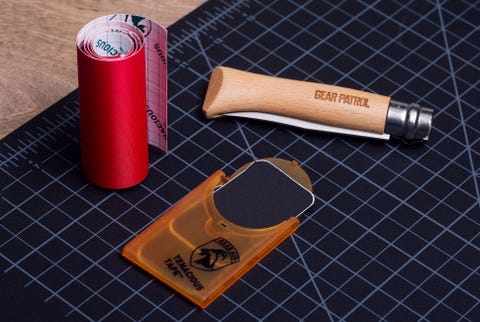Repairing a rip in your rain jacket can save you a ton of coin, and it’s better for the environment to keep a jacket’s worth of plastic out of the landfill. Plus, it’s dead simple. Thanks to brands like Gear Aid, even the least DIY-capable person can repair a rain jacket in about 20 minutes.
Assess the damage
If it’s only a small tear (about the size of a quarter), you’re in luck: This is much easier to repair, and chances are it will be a lasting fix. For a larger tear (bigger than a quarter), you still have a shot. Begin by cleaning up any loose fibers with scissors.
Use this time to inspect the lining of your jacket. If the lining is peeling or delaminating, then chances are your jacket isn’t worth saving. If you can, take your jacket to a recycling center. Most Patagonia stores and some other gear shops accept well-loved rain jackets and will recycle them. Also, keep an eye out for abrasions and high-wear areas on the face fabric of the jacket, as those will be locations of future repairs.
Make sure your jacket is clean
If you haven’t washed your jacket in a while, throw it in a washing machine. Not only does regularly washing your jacket with a specially formulated detergent prolong its lifespan, but it also gives you the opportunity to re-waterproof the jacket. (Here's how to do that.)
Make the repair
For a large tear, consider using a needle and thread before patching or taping. If you aren’t any good at sewing, this is best left to the professionals. Take the jacket to a tailor or seamstress to have the tear stitched back together. This can help make for a stronger repair, but if you aren’t careful, you can further damage your jacket.
In most cases, though, using only Tenacious Tape is suitable. Depending on which type of tape you have — e.g., a roll or pre-cut patches — step three will be different:
For the roll: Roll out a piece that will cover the tear with about an inch of space on all sides. Cut the tape from the rest of the roll. Trim the corners with scissors or a knife and round it out into either a circle or an oval. Eliminating corners decreases the chances of the patch catching on something and/or beginning to peel down the road.
For the patches: Pull the patch out of its container. Measure to make sure it will overlap the tear by about an inch on all sides.
Apply the Tenacious Tape
Peel the backing from the Tenacious Tape and carefully apply it to the outer fabric of your jacket. As you press down, start in the center and work your way out. This will help to avoid air bubbles. Allow the patch to set for 24 hours before wearing it.
Repeat the previous two steps on the inside of the jacket
While not completely necessary for small tears, adding a patch on the inside of the jacket can help to seal out water completely and make for a lasting repair. For a larger tear, this step is mandatory. Once the inner patch is applied, allow it to set for 24 hours before wearing it.
You can also follow steps two through four to repair pinholes and small tears in down and synthetic insulation jackets.

























